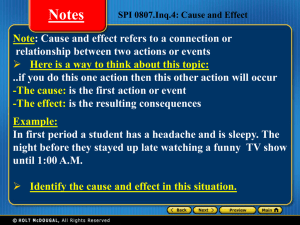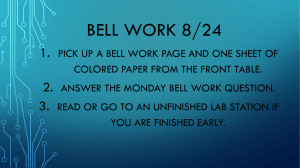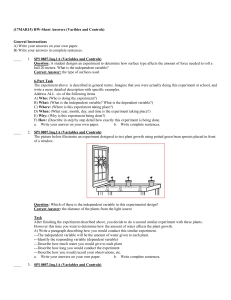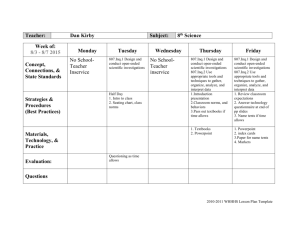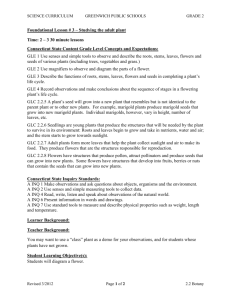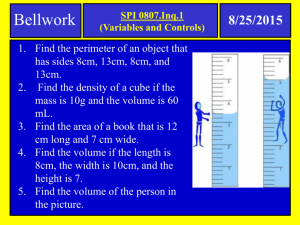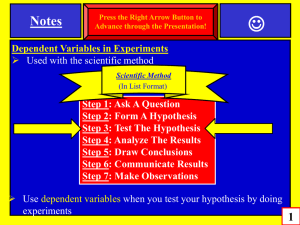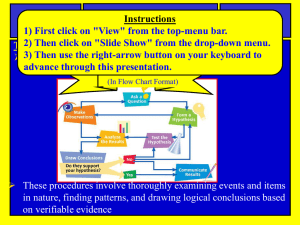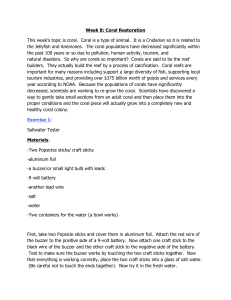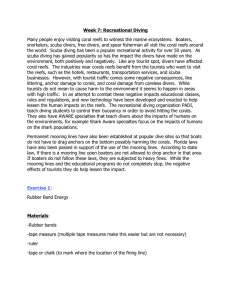Week 5: Archeology
advertisement
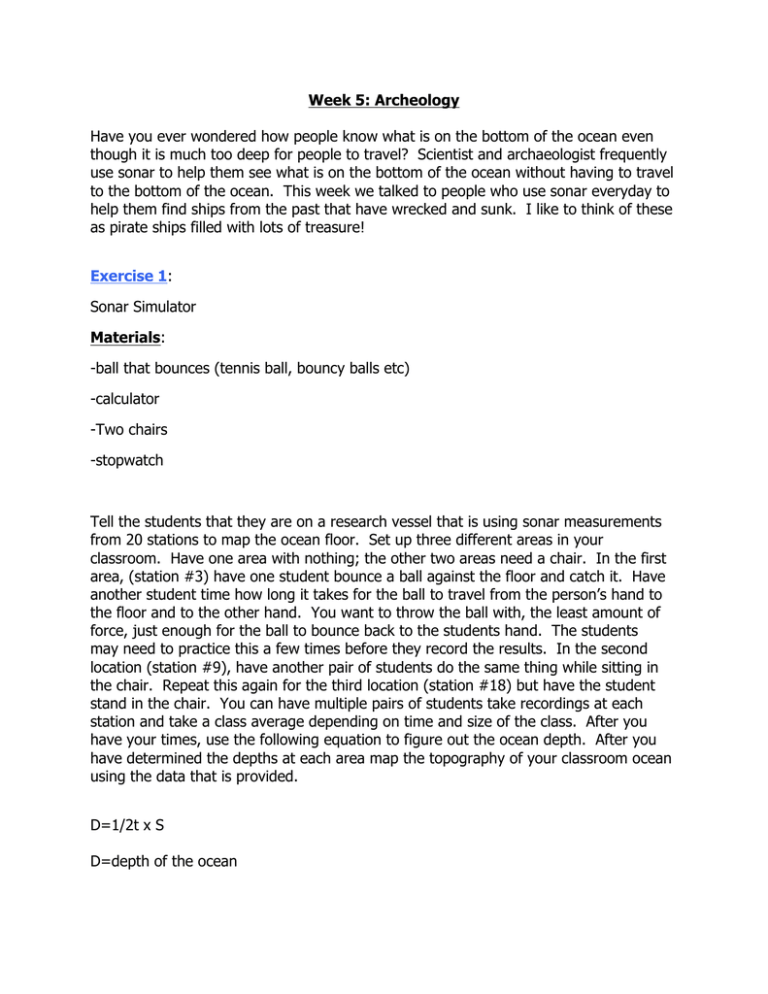
Week 5: Archeology Have you ever wondered how people know what is on the bottom of the ocean even though it is much too deep for people to travel? Scientist and archaeologist frequently use sonar to help them see what is on the bottom of the ocean without having to travel to the bottom of the ocean. This week we talked to people who use sonar everyday to help them find ships from the past that have wrecked and sunk. I like to think of these as pirate ships filled with lots of treasure! Exercise 1: Sonar Simulator Materials: -ball that bounces (tennis ball, bouncy balls etc) -calculator -Two chairs -stopwatch Tell the students that they are on a research vessel that is using sonar measurements from 20 stations to map the ocean floor. Set up three different areas in your classroom. Have one area with nothing; the other two areas need a chair. In the first area, (station #3) have one student bounce a ball against the floor and catch it. Have another student time how long it takes for the ball to travel from the person’s hand to the floor and to the other hand. You want to throw the ball with, the least amount of force, just enough for the ball to bounce back to the students hand. The students may need to practice this a few times before they record the results. In the second location (station #9), have another pair of students do the same thing while sitting in the chair. Repeat this again for the third location (station #18) but have the student stand in the chair. You can have multiple pairs of students take recordings at each station and take a class average depending on time and size of the class. After you have your times, use the following equation to figure out the ocean depth. After you have determined the depths at each area map the topography of your classroom ocean using the data that is provided. D=1/2t x S D=depth of the ocean t=echo time (time it takes the ball to travel from one hand to the other) S= speed of sound in the water: 5,000 ft/s (feet per second) For example: Station 3: Student A: 1.03sec Student B: .66 sec Student C: .87 sec Student D: .57 sec First, take an average of the echo times 1.03+.66+.87+.57=3.13 3.13/4=.783 Therefore, the average echo time was .783 D=1/2t x S D=1/2(. 783sec) x 5, 000ft/s D=1957.5 ft So station 3 in your classroom ocean is 1, 957.5ft deep Graphing: Open the following excel sheet and insert the class data into the blank boxes. Station 3, 9 and 18 are missing the ocean depths. These were obtained in your classroom. Station 3 is where the students sat in the chair. Station 9 is the station where the students stood on the ground. Station 18 is where the students stood on the chair. The EXCEL sheet Here is a sample of what your graph could look like. Ocean Depths Distance From Shore in Miles 10 20 30 40 50 60 70 80 90 100 110 120 130 140 150 160 170 180 190 200 Ocean Depth in Feet 0 100 200 Ocean Depth 300 400 500 600 For a more advance graph, use the following data from University of Virginia: http://galileo.phys.virginia.edu/outreach/8thGradeSOL/Sonar.htm For a more in depth experiment on using sonar’s please visit: http://oceanservice.noaa.gov/education/seafloor-mapping/sounding_box_make1.html What is happening? The experiment is simulating sonar. Sonar is an acronym for Sound Navigation and Ranging. Sonar transmitters send out sound waves that travel though the water until it reaches the bottom or an object. The sound bounces off the bottom or the transmitter picks up object and the sound waves. The time it takes the sound wave to leave the transmitter and return is called the echo time. In this experiment, the ball was used instead of sound waves to figure out the "depth" of the ocean. How this relates to Jessica and Bruce: Sonar has many different applications in the ocean. Scientists use sonar to map the ocean floors, archaeologists use sonar to help find the wrecks of old ships, and fishermen use sonar to find schools of fish underwater. Sonar is also used as part of rescues and crime scene investigations for locating bodies and weapons. There are even animals that use a form of sonar called echolocation! Can you name some animals that use echolocation? How else have you heard of sonar being used? Definitions: -Sonar: Sound navigation and ranging. A system for the detection of objects under water and for measuring the water's depth by emitting sound pulses and detecting or measuring their return after being reflected. -Echo time: the time it takes the sound waves to leave the transmitter hit and object and return to the transmitter. -Topography: A detailed description or representation on a map of the natural and artificial features of an area. -Echolocation: A physiological process for location distant or invisible objects by sound waves reflected back to the emitter from the objects Questions: 1. How does sonar work? 2. How do animals use echolocation? 3. What does sonar stand for? 4. How does sonar make mapping the ocean easier for scientists? 5. How do submarines detect explosives? 6. How would sonar help divers who were trying to find something in water that had very poor visibility? Related topics: Finding the missing Beijing flight Underwater CSI uses sonar to locate bodies, or items used in a crime scene. Echolocation in marine mammals How do marine mammals communicate over long distances sound waves? Exercise 2: Floating Hot and Cold Materials: -glass bowl or clear pitcher -hot water -cold water bottle of water (16-20oz) -food coloring Fill a glass bowl (or a clear pitcher) with hot water a little over half full. Now add a drop of food coloring to a cold bottle of water. While the water bottle is sealed with your finger, place the bottle upside down in the hot water and slowly release the cold water (be careful you do not burn yourself). Which way does the cold water travel? Does it stay in the bottle? What happens to the water as it starts to warm? Make sure to tell the students to watch where the two waters are separated. What is happening? As we have discussed, the denser something is the more likely, it will sink, but did you know that temperature could play a big part in how dense something is? When the water is warmer, the molecules are moving faster and spread out meaning that there are fewer molecules in a given volume. The cold-water molecules are moving less and they become closely packed. This means that the cold water is denser because it has more molecules in a given volume. Because the cold water is denser, it sinks. As the water, starts to warm the molecules spread back out and the water will start to rise and mix with the warmer water. The cold water has more molecules packed closely together so it is denser. In the red water, warm water, molecules are more spread out so the water is less dense. How this relates to Jessica and Bruce: Large bodies of water heat up and cool off at different rates depending on the season and the size of the body of water. This causes what is called a thermocline. A thermocline is where water of two different temperatures meets. The warmer water is towards the surface while colder water is on the bottom. As the seasons change so does the temperature of the water. Fresh water systems experience what is called overturn. In the summer, the water on top becomes warmer, less dense, so it floats on the cold water. In the fall and winter, the water becomes colder until the entire body of water is the same temperature. The water that was on the bottom can now easily circulate and it will bring with it nutrients. Similarly, the oceans have upwellings. The wind will push against the surface of the water moving the top water, which then "pulls" water that is colder up to the top of the water. Divers have to be cautious of the thermocline when diving because the temperature change can be dramatic. The surface of the water may be 75 degrees but only 60 degrees below the thermocline. There are actually places where this is reversed and the deeper you dive the warmer the water temperature. Definitions: -Thermocline: A steep temperature gradient in a body of water such as a lake, marked by a layer above and below which the water is at different temperatures. -Upwelling: a rising of seawater, magma or other liquid -Density: The amount of matter contained in a given space or volume Questions: 1. What happened to the cold water when it was poured into the warm water? 2. What happened to the cold water that was next to the warm water? 3. What happens to the water after it was left for a while? 4. Why are upwellings and overturn important to ecosystems? 5. What is a thermocline? Related topics: Seasonal upwellings on the continental shelves: could it bring other items besides nutrients? Links Sonar Simulator http://galileo.phys.virginia.edu/outreach/8thGradeSOL/Sonar.htm http://www.ehow.com/info_7879441_sonar-classroom-activities.html http://www.education.com/science-fair/article/sonar-mapping-ocean-floor/ http://www.pbslearningmedia.org/resource/phy03.sci.phys.mfw.sonar/sound-wavesunderwater-experiment-with-sonar/ http://www.juliantrubin.com/encyclopedia/electronics/sonar.html http://www.education.com/science-fair/article/soundings/ http://mjksciteachingideas.com/pdf/MappingMedium.pdf http://oceanservice.noaa.gov/education/seafloor-mapping/sounding_box_make1.html Floating and sinking water http://serc.carleton.edu/sp/mnstep/activities/25754.html http://www.scienceprojectideas.co.uk/warm-cold-heavy-water.html Answers: 1. How does sonar work? a. Transmitters send out sound waves that travel through the water until it reaches the bottom or an object and is reflected back to the transmitter. 2. How do animals use echolocation? a. They use it to find prey and to see 3. What does sonar stand for? a. Sound Navigation and Ranging 4. How does sonar make mapping the ocean easier for scientists? a. They can map the bottom of the ocean even if they cannot see the bottom or travel to the bottom. 5. How do submarines detect explosives? a. They use sonar 6. How would sonar help divers who were trying to find something in water that had very poor visibility? a. They could rely on the sonar to see the bottom composition 1. What happened to the cold water when it was poured into the warm water? a. It sank to the bottom 2. What happened to the cold water that was next to the warm water? a. It started to warm and started to mix with the warm water 3. What happens to the water after it was left for a while? a. The water temperature became uniform and all of the water was able to mix 4. Why are upwellings and overturn important to ecosystems? a. They bring up needed nutrients 5. What is a thermocline? a. A steep temperature gradient in a body of water such as a lake, marked by a layer above and below which the water is at different temperatures. Tennessee State Standards: Grade 6 :Embedded Inquiry Conceptual Strand Understandings about scientific inquiry and the ability to conduct inquiry are essential for living in the 21st century. Guiding Question What tools, skills, knowledge, and dispositions are needed to conduct scientific inquiry? Grade Level Expectations GLE 0607.Inq.1 Design and conduct open- ended scientific investigations. GLE 0607.Inq.2 Use appropriate tools and techniques to gather, organize, analyze, and interpret data. GLE 0607.Inq.3 Synthesize information to determine cause and effect relationships between evidence and explanations. GLE 0607.Inq.4 Recognize possible sources of bias and error, alternative explanations, and questions for further exploration. GLE 0607.Inq.5 Communicate scientific understanding using descriptions, explanations, and models. Checks for Understanding 0607.Inq.1Design and conduct an open-ended scientific investigation to answer a question that includes a control and appropriate variables. 0607.Inq.2 Identify tools and techniques needed to gather, organize, analyze, and interpret data collected from a moderately complex scientific investigation. 0607.Inq.3 Use evidence from a dataset to determine cause and effect relationships that explain a phenomenon. 0607.Inq.4 Review an experimental design to determine possible sources of bias or error, state alternative explanations, and identify Questions for further investigations. 0607.Inq.S Design a method to explain the results of an investigation using descriptions, explanations, or models. State Performance Indicators SPI 0607.Inq.1Design a simple experimental procedure with an identified control and appropriate variables. SPI 0607.Inq.2 Select tools and procedures needed to conduct a moderately complex experiment. SPI 0607.Inq.3 Interpret and translate data in a table, graph, or diagram. SPI 0607.Inq.4 Draw a conclusion that establishes a cause and effect relationship supported by evidence. SPI 0607.Inq.5 Identify a faulty interpretation of data that is due to bias or experimental error. Grade 6 :Embedded Technology & Engineering Conceptual Strand Society benefits when engineers apply scientific discoveries to design materials and processes that develop into enabling technologies. Guiding Question How do science concepts, engineering skills, and applications of technology improve the quality of life? Grade Level Expectations GLE 0607.T/E.1Explore how technology responds to social, political, and economic needs. GLE 0607.T/E.2 Know that the engineering design process involves an ongoing series of events that incorporate design constraints, model building, testing, evaluating, modifying, and retesting. GLE 0607.T/E.3 Compare the intended benefits with the unintended consequences of a new GLE 0607.T/E.4 Describe and explain adaptive and assistive bioengineered products. Checks for Understanding 0607.T/E.1Use appropriate tools to test for strength, hardness, and flexibility of materials. 0607.T/E.2 Apply the engineering design process to construct a prototype that meets certain specifications. 0607.T/E.3 Explore how the unintended consequences of new technologies can impact society. 0607.T/E.4 Research bioengineering technologies that advance health and contribute to improvements inour daily lives. 0607.T/E.5 Develop an adaptive design and test its effectiveness. State Performance Indicators SPI 0607.T/E.1Identify the tools and procedures needed to test the design features of a prototype. SPI 0607.T/E.2 Evaluate a protocol to determine if the engineering design process was successfully applied. SPI 0607.T/E.3 Distinguish between the intended benefits and the unintended consequences of a new technology. technology. SPI 0607.T/E.4 Differentiate between adaptive and assistive engineered products (e.g., food, biofuels, medicines, integrated pest management). Grade 7 : Embedded Inquiry Conceptual Strand Understandings about scientific inquiry and the ability to conduct inquiry are essential for living in the 21st century. Guiding Question What tools, skills, knowledge, and dispositions are needed to conduct scientific inquiry? Grade Level Expectations GLE 0707.Inq.1 Design and conduct open- ended scientific investigations. GLE 0707.Inq.2 Use appropriate tools and techniques to gather, organize, analyze, and interpret data. GLE 0707.Inq.3 Synthesize information to determine cause and effect relationships between evidence and explanations. GLE 0707.Inq.4 Recognize possible sources of bias and error, alternative explanations, and questions for further exploration. GLE 0707.Inq.5 Communicate scientific understanding using descriptions, explanations, and models. Checks for Understanding 0707.Inq.1 Design and conduct an open-ended scientific investigation to answer a question that includes a control and appropriate variables. 0707.Inq.2 Identify tools and techniques needed to gather, organize, analyze, and interpret data collected from a moderately complex scientific investigation. 0707.Inq.3 Use evidence from a dataset to determine cause and effect relationships that explain a phenomenon. 0707.Inq.4 Review an experimental design to determine possible sources of bias or error, state alternative explanations, and identify questions for further investigation. 0707.Inq.5 Design a method to explain the results of an investigation using descriptions, explanations, or models. State Performance Indicators SPI 0707.Inq.1 Design a simple experimental procedure with an identified control and appropriate variables. SPI 0707.Inq.2 Select tools and procedures needed to conduct a moderately complex experiment. SPI 0707.Inq.3 Interpret and translate data in a table, graph, or diagram. SPI 0707.Inq.4 Draw a conclusion that establishes a cause and effect relationship supported by evidence. SPI 0707.Inq.5 Identify a faulty interpretation of data that is due to bias or experimental error. Grade 7 : Embedded Technology & Engineering Conceptual Strand Society benefits when engineers apply scientific discoveries to design materials and processes that develop into enabling technologies. Guiding Question How do science concepts, engineering skills, and applications of technology improve the quality of life? Grade Level Expectations GLE 0707.T/E.1 Explore how technology responds to social, political, and economic needs. GLE 0707.T/E.2 Know that the engineering design process involves an ongoing series of events that incorporate design constraints, model building, testing, evaluating, modifying, and retesting. GLE 0707.T/E.3 Compare the intended benefits with the unintended consequences of a new technology. GLE 0707.T/E.4 Describe and explain adaptive and assistive bioengineered products. Checks for Understanding 0707.T/E.1 Use appropriate tools to test for strength, hardness, and flexibility of materials. 0707.T/E.2 Apply the engineering design process to construct a prototype that meets certain specifications. 0707.T/E.3 Explore how the unintended consequences of new technologies can impact society. 0707.T/E.4 Research bioengineering technologies that advance health and contribute to improvements in our daily lives. 0707.T/E.5 Develop an adaptive design and test its effectiveness. State Performance Indicators SPI 0707.T/E.1 Identify the tools and procedures needed to test the design features of a prototype. SPI 0707.T/E.2 Evaluate a protocol to determine if the engineering design process was successfully applied. SPI 0707.T/E.3 Distinguish between the intended benefits and the unintended consequences of a new technology. SPI 0707.T/E.4 Differentiate between adaptive and assistive engineered products (e.g., food, biofuels, medicines, integrated pest management). Grade 8 : Embedded Inquiry Conceptual Strand Understandings about scientific inquiry and the ability to conduct inquiry are essential for living in the 21st century. Guiding Question What tools, skills, knowledge, and dispositions are needed to conduct scientific inquiry? Grade Level Expectations GLE 0807.Inq.1 Design and conduct open- ended scientific investigations. GLE 0807.Inq.2 Use appropriate tools and techniques to gather, organize, analyze, and interpret data. GLE 0807.Inq.3 Synthesize information to determine cause and effect relationships between evidence and explanations. GLE 0807.Inq.4 Recognize possible sources of bias and error, alternative explanations, and questions for further exploration. GLE 0807.Inq.5 Communicate scientific understanding using descriptions, explanations, and models. Checks for Understanding 0807.Inq.1 Design and conduct an open-ended scientific investigation to answer a question that includes a control and appropriate variables. 0807.Inq.2 Identify tools and techniques needed to gather, organize, analyze, and interpret data collected from a moderately complex scientific investigation. 0807.Inq.3 Use evidence from a dataset to determine cause and effect relationships that explain a phenomenon. 0807.Inq.4 Review an experimental design to determine possible sources of bias or error, state alternative explanations, and identify questions for further investigation. 0807.Inq.5 Design a method to explain the results of an investigation using descriptions, explanations, or models. State Performance Indicators SPI 0807.Inq.1 Design a simple experimental procedure with an identified control and appropriate variables. SPI 0807.Inq.2 Select tools and procedures needed to conduct a moderately complex experiment. SPI 0807.Inq.3 Interpret and translate data into a table, graph, or diagram. SPI 0807.Inq.4 Draw a conclusion that establishes a cause and effect relationship supported by evidence. SPI 0807.Inq.5 Identify a faulty interpretation of data that is due to bias or experimental error. Grade 8 : Embedded Technology & Engineering Conceptual Strand Society benefits when engineers apply scientific discoveries to design materials and processes that develop into enabling technologies. Guiding Question How do science concepts, engineering skills, and applications of technology improve the quality of life? Grade Level Expectations GLE 0807.T/E.1 Explore how technology responds to social, political, and economic needs. GLE 0807.T/E.2 Know that the engineering design process involves an ongoing series of events that incorporate design constraints, model building, testing, evaluating, modifying, and retesting. GLE 0807.T/E.3 Compare the intended benefits with the unintended consequences of a new technology. GLE 0807.T/E.4 Describe and explain adaptive and assistive bioengineered products. Checks for Understanding 0807.T/E.1 Use appropriate tools to test for strength, hardness, and flexibility of materials. 0807.T/E.2 Apply the engineering design process to construct a prototype that meets certain specifications. 0807.T/E.3 Explore how the unintended consequences of new technologies can impact society. 0807.T/E.4 Research bioengineering technologies that advance health and contribute to improvements in our daily lives. 0807.T/E.5 Develop an adaptive design and test its effectiveness. State Performance Indicators SPI 0807.T/E.1 Identify the tools and procedures needed to test the design features of a prototype. SPI 0807.T/E.2 Evaluate a protocol to determine if the engineering design process was successfully applied. SPI 0807.T/E.3 Distinguish between the intended benefits and the unintended consequences of a new technology. SPI 0807.T/E.4 Differentiate between adaptive and assistive engineered products (e.g., food, biofuels, medicines, integrated pest management). National Standards: Middle School Earth and Space Science History of Earth 1. Analyze and interpret data on the distribution of fossils and rocks, contintental shapes, and seafloor structures to provide evidence of the past plate motions. MS-ESS2-3 a. Clarification Statement: Examples of data include similarities of rock and fossil types on different continents, the shapes of the continents (including continental shelves), and the locations of ocean structures (such as ridges, fracture zones, and trenches). b. Assessment Boundary: Paleomagnetic anomalies in oceanic and continental crust are not assessed. Middle School Physical Science Structure and properties of matter 1. Develop a model that predicts and describes changes in particle motion, temperature, and state of a pure substance when thermal energy is added or removed. MS-PS1-4 a. Clarification Statement: Emphasis is on qualitative molecular-level models of solids, liquids, and gases to show that adding or removing thermal energy increases or decreases kinetic energy of the particles until a change of state occurs. Examples of models could include drawing and diagrams. Examples of particles could include molecules or inert atoms. Examples of pure substances could include water, carbon dioxide, and helium. b. Assessment Boundary: none
